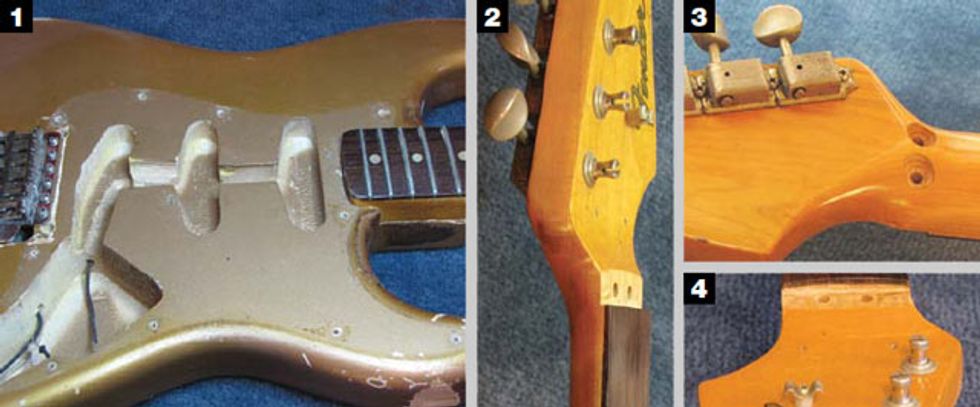
1. This ’65 Strat’s original Shoreline Gold finish had been preserved by the pickguard, and removing it reveals the brighter, bronze color. The surrounding warmer gold hue is a result of the body being exposed to air for 55 years. Incidentally, when ordered with this custom color, not all Fender models came with a matching color peghead. 2. At some point, a Floyd Rose tremolo system had been installed on this vintage Strat. This mod required removing a section of the Brazilian rosewood fretboard and maple neck to accommodate the locking nut hardware. 3. Two counterbored holes had been drilled through the neck at the headstock. 4. Two smaller screw holes were also drilled to hold the Floyd string-retainer bar. Notice how the rosewood fretboard is radiused on both its top and bottom surfaces.
Recently, my friends from solidbodyguitar.com gave me a call and said they had a really cool vintage guitar they were going to sell, but it was in need of some restoration before they put it up for sale. They wouldn’t say what it was, opting instead to surprise me when they dropped it off.
When the clients arrived at my shop to show me the guitar, we first began chatting about their ’62 SG Les Paul. I was in the process of restoring its relic’d white finish, getting it ready for market. It was as if they were saving the best for last, building up my anticipation and curiosity about the instrument they were delivering. When they finally got around to opening up the case, I was surprised and delighted to see a real and extremely rare 1965 Fender Stratocaster in Shoreline Gold.
The guitar arrived to us with the pickguard and electronics already removed. Abruptly my eyes were drawn towards the finish outline of the pickguard. Strikingly, there were two shades of finish. The pickguard preserved the original color underneath, while the rest of the body had developed this warm, gold look from the open-air environment. To me, the aged Shoreline Gold is a much more soothing and pleasing color to the eyes—less bronze and more gold. I’m sure glad Fender was spraying nitrocellulose finish back then, as it allowed this transformation to occur.
A quick aside: Shoreline Gold is a finish seen by few and the most misunderstood and incorrectly used term for referencing Fender gold colors. Shoreline Gold was introduced in 1959 and was discontinued by the end of 1965, and then replaced by Firemist Gold, which was not the same color at all.
As I checked out this cool Strat, it became immediately clear why it was brought to us. Ouch! Someone had decided to rock out and install a Floyd Rose locking nut and tremolo. My educated guess is that the procedure was done some time in the ’80s. I really like Floyds and we often do this modification, but for no amount of money will we do this modification to a vintage guitar. In our world, it would be considered malpractice and a good way to have a short-lived career in the repair business. It’s true that this 1965 Stratocaster is devalued because of its alterations, but let there be no mistake: This guitar is still a highly valued treasure!
When we received the Strat, its original vintage Fender bridge and tremolo system had been put back on the body. But because of the Floyd Rose installation, there were now two screw holes going through the maple neck and a slab of Brazilian rosewood had been removed from the fretboard to mount the hardware. My clients requested that I restore the fretboard and neck portion where the Floyd Rose nut had been positioned. They were pleased to hear that I had some smaller pieces of vintage maple and Brazilian rosewood in the shop that would work perfectly for this restoration. The issue of legal and illegal wood has been in the news recently, so my clients were relieved when I informed them that my reclaimed and salvaged Brazilian rosewood is properly validated and permitted by CITES (Convention on International Trade in Endangered Species of Wild Fauna and Flora).
I’ve seen some Indian rosewood come very close to looking like Brazilian for patching purposes, but I really want to use the real deal for such a spectacular guitar. My approach will be to get the restored fretboard and nut to look era-correct and match the original cosmetics as closely as possible.
The two counterbored holes that run through the maple neck will not have an invisible repair, but they will be smooth to the touch and structurally sound. There are also two very small screw holes in the peghead where the steel string-retainer bar was positioned behind the Floyd Rose locking nut. These need minor restoration as well.
When the section of the neck was previously leveled to accommodate the Floyd Rose nut, not only was fretboard wood removed, but also maple underneath the rosewood. The slab of replacement maple will need a flat bottom and a 7.25" radius top—the surface I glue the Brazilian rosewood fretboard section to. After the fretboard wood is trimmed and fit, I’ll then slot it for a nut. Fender began using this style of veneer fretboard during August of 1962.
In next month’s column, we’ll be diving headfirst into this restoration. I’m certain to encounter challenges, and I’ll share those gory details with you, as well as techniques I use to get the job done. See you then.
 John Brown is the
inventor of the Fretted/Less
bass. He owns and operates
Brown’s Guitar Factory,
a guitar manufacturing,
repair, and restoration facility
staffed by a team of talented
luthiers. His guitar-tool and accessory designs
are used by builders all over the world. Visit
brownsguitarfactory.com or email John at
info@brownsguitarfactory.com.
John Brown is the
inventor of the Fretted/Less
bass. He owns and operates
Brown’s Guitar Factory,
a guitar manufacturing,
repair, and restoration facility
staffed by a team of talented
luthiers. His guitar-tool and accessory designs
are used by builders all over the world. Visit
brownsguitarfactory.com or email John at
info@brownsguitarfactory.com.





![Rig Rundown: Russian Circles’ Mike Sullivan [2025]](https://www.premierguitar.com/media-library/youtube.jpg?id=62303631&width=1245&height=700&quality=70&coordinates=0%2C0%2C0%2C0)

















